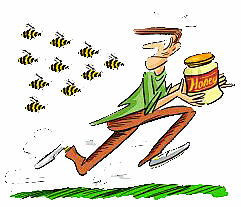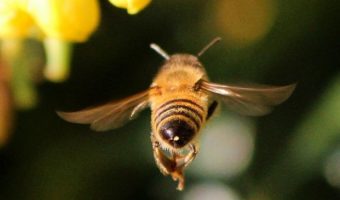Last updated on April 23rd, 2025 at 01:43 am
by Rachel Paxton

My son got his first bee sting this morning. There was a dead (or so I thought) wasp lying on the floor of our dining room. I was talking to our daughter on the phone and was going to dispose of the bee as soon as I got off the phone. Not a minute later, my two-year-old son was crying because he had touched the bee and it had stung the end of his finger! I looked closely at the bee and saw it was still alive, though barely. Just alive enough to sting, apparently!
Fortunately the stinger didn’t lodge in my son’s finger and the pain didn’t last long. I coated the area with a paste of baking soda and water, which he couldn’t resist licking off after a couple of minutes. The pain disappeared after an hour or so, with no apparent allergic reactions, thank goodness.
If you or one of your children gets stung by a bee, the first thing you need to do is determine if there is a stinger that needs to be removed from the skin. Wasps, hornets, and yellow jackets do not leave their stingers behind. A honey bee, however, leaves its stinger embedded in the skin, and the stinger will then need to be removed.

The main thing to keep in mind while removing the stinger is that you don’t want to pull it out by squeezing it, such as with a pair of tweezers. Squeezing the stinger will release any remaining poison and actually worsen the sting. Gently scrape against the side of the stinger with your fingernail until the stinger is dislodged. Next apply an ice pack to help reduce swelling.
A number of home remedies are available for lessening the effects of a bee sting. These remedies have been proven to be as good or better than their store-bought alternatives. The main objective is to use something that will neutralize the acid contained in the bee’s poison:
Home Remedies for Bee Stings
– Apply a paste of baking soda and water
– Apply a paste of meat tenderizer and water
– Apply household ammonia directly to sting (many store-bought remedies list ammonia as one of the main ingredients)
– Apply a paste of aspirin dissolved in water
– Apply toothpaste
– Apply apple cider vinegar
If you see any signs of an allergic reaction to the bee sting you should see a doctor immediately. Signs of allergic reaction include hives, headache, trouble breathing, tightness in the throat or chest, dizziness, nausea, or vomiting. Also see a doctor if swelling spreads to a large area of the body or if pain and swelling last more than three days.
Related Posts: Medicinal Uses of Geraniums, How to Make Herbal Tinctures
About the Author: Rachel Paxton is a freelance writer and mom who is the author of What’s for Dinner?, an e-cookbook containing more than 250 quick easy dinner ideas.

